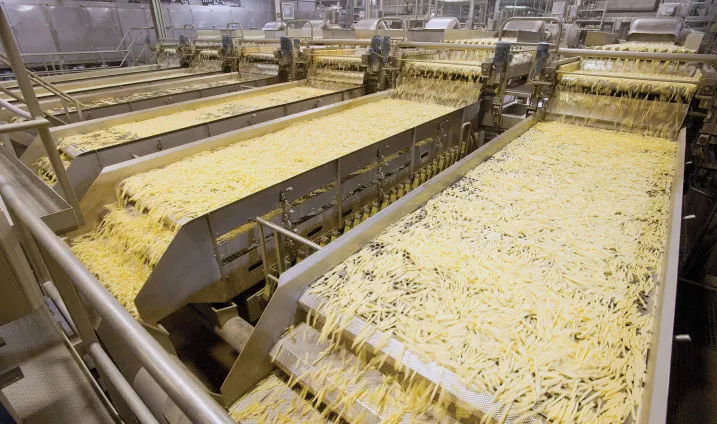The process – From potato to fries Tuesday 10 December 2019

The evolution from a potato to fry seems simple – we can all craft a fry, can’t we? But to get it spot on, every time, is not quite that simple.
Our process starts with you.
We work with our customers; chefs; and consumers to understand exactly what you’re looking for. Your preferences determine the type and quantity of potatoes we use, as well as where and when they are needed. Before we even start to grow the potatoes, we are thinking customer first.
After the potatoes arrive at our processing facilities, the first step is to check the quality. We unload the potatoes & remove FM (metal, clay, sand, vine and stone); clean all the crop; then sort them. Since potatoes are a natural product, not every one is the same size. They are then stored according to size in 'storage bunkers', and passed through a salt bath to the factory.
Lovingly brushed
We know that our growers provide us with the best possible potatoes; however, because these are a natural product, they are not all the same. Only the best is good enough for our customers, so we take no risks and inspect every single potato we receive. All day long. In other words, old-fashioned quality control.
It's now time to peel the potatoes.
A team of 250 men and women work on the conveyor belts daily, peeling hundreds of thousands... No, that's not how it works. Everything's fully automated these days! If we’re creating skin-off products, steam and high pressure are used to peel the potatoes extremely quickly. They then get to enjoy a bath and be lovingly brushed.
Rotating blades
To make it easier to cut the potatoes they are first heated in hot water, which softens them up. We also innovatively give the potatoes an electric shock. This pioneering technique has been introduced at several Lamb Weston locations.
The potatoes are then transported using water pressure to the blades via a simple funnel. The funnel shape ensures that the potatoes are always cut lengthwise, resulting in nice long fries. Alternatively, by having the blades rotate, you can also cut other styles of fries, such as Twisters. Lamb Weston has even patented this cutting process!
Blown away
On occasion, there may be fries with imperfections. Obviously, these have to be removed. Not to worry! All fries pass through a high-tech scanner at high speed. If there are any irregularities, the optical scanner detects them, and the culprit is simply blown away. Off you go!
Everything throughout our process is designed to ensure we are producing the perfect fry for our customers. We not only cut everything into the perfect shape, but we also blanch; dry; where necessary, cover with batter; then precook the fries for you. All fries are cooked at 180*C for around a minute. Afterwards, they immediately move to the freezing tunnel and packaging unit. They're put into a bag, quality checked, and then placed in a box, which goes onto a pallet and finally, transported into the cold storage warehouse, ready for dispatch.
No rest for the wicked
The entire process continues at full speed for three weeks. We then halt all production for 32 hours. To take a break? Not really. To clean everything from the inside out. And we mean everything in the entire factory. That's because we feel very strongly about hygiene. After all, that contributes to the perfect fry. These 32 hours are also used for maintenance.
At our Lamb Weston plant in Europe 3.6 million kilos of potatoes arrive every day. That's 121 lorries full! In the EU and Middle East, 12 million servings of our fries are consumed daily. And in our European processing facilities, our annual consumption rates are:
- 40 million m2 (partly recycled) of cardboard packaging
- 4.2 tonnes of plastic foil for packaging the fries
- 43 million litres of oil for precooking
Reducing transport
It may sound complicated, but the ultimate goal is to deliver a quality product to you. Transport is also an important consideration. Our transport is as sustainable as possible: the freshly frozen fries are dispatched in containers from our cold storage facility in the Netherlands (Bergen op Zoom) to Rotterdam by barges. This has reduced the number of lorries on the road by 120 to 160. 95% of transport to the rest of Europe - to Italy, Spain, Poland and Sweden - is done by train. Only express shipments are dispatched by lorry.